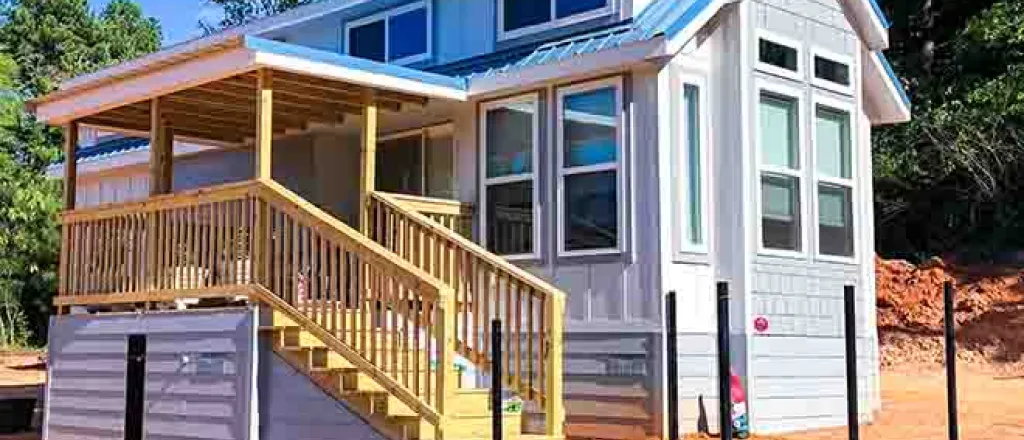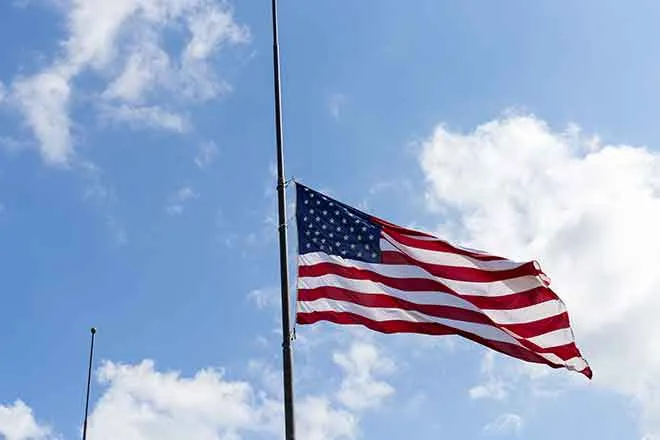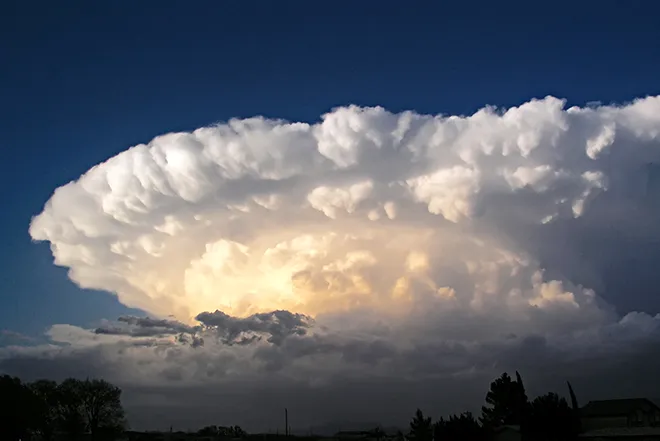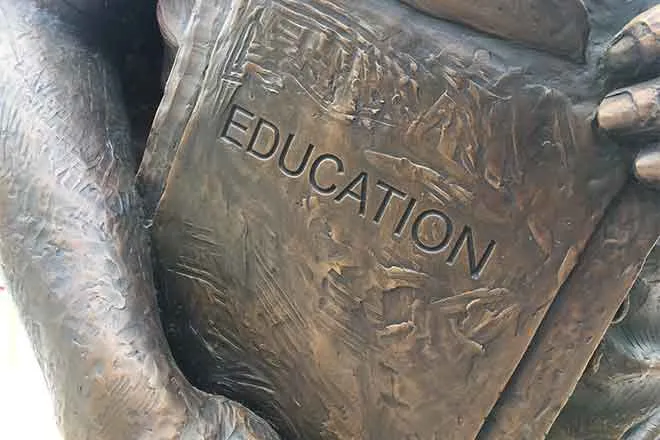
Nonprofit group builds tiny homes to shelter Arizona youths
For more than three years, 23-year-old Baneen Albotaify bounced from one friend's house to another, sleeping on couches or in laundry rooms while working on her college degree. The stress was high, but she couldn't afford a place of her own.
"I was really depressed. I was always in survival mode," says Albotaify, who lives in Tucson, Arizona.
After a friend told her about I Am You 360, a nonprofit that provides housing for young people, she applied for the program and her life began to change for the better. Albotaify is currently living in a studio apartment in a 10-unit building run by the nonprofit, alongside other formerly unhoused folks. She now works as an electrical technician and, after taking a semester off school, she plans to continue college in the fall.
By year's end, Albotaify and some of her fellow tenants are slated to move into a new I Am You 360 housing project: an eco-friendly tiny house village currently under construction that, when completed, will include 10 homes, a water-harvesting system, and a community garden.
"We want to set them up for success," says Desiree Cook, the nonprofit's founder and executive director.
Success, for Cook, means integrating unsheltered young people back into society as well-rounded productive citizens. With a place to live, Cook says, these young people will no longer be continually victimized in the streets. While living in the tiny houses, tenants will have access to not only various tools that will help them forge a new life, but also common spaces where they can build community.
"There's a difference between giving someone a house and giving them a house so that it can be a home," Cook says.
The tiny-house village will be Tucson's first, but in recent years, cities from Seattle to Los Angeles to Madison, Wisconsin, to Austin, Texas, have turned to these affordable and energy-efficient living spaces to shelter people experiencing homelessness. Although programs and resources vary greatly, tiny houses are usually a step up from overnight shelters and short-term transitional housing, because they can provide shelter for longer periods of time, and act as a bridge to permanent housing.
I Am You 360 settled on a construction method known as insulated concrete form for its tiny houses: interlocking modular foam blocks that are stacked and then filled with concrete. This method appealed to the nonprofit because it's more energy-efficient and more durable than wood-frame houses, which will mean more utilities savings for tenants in the long run.
"We want our homes to be more sustainable, so they can be here for generations to come," Cook says.
But housing advocates say the tiny house trend (like all proposed housing solutions) is not an end-all to homelessness if it doesn't include access to services people need to stay healthy and keep a roof over their heads.
"A lot depends on whether it's part of a coordinated strategy to reduce homelessness or just a form of shelter that's put out there with nothing else," says Steve Berg, vice president of programs and policy at the National Alliance to End Homelessness. "I think that's the key today."
The nation's homeless population totaled about 580,000 on a single night in January 2020, according to an annual survey by the U.S. Department of Housing and Urban Development (HUD). Slightly more than 34,000 were unaccompanied young people, and of those, 90% were between the ages of 18 and 24. In Arizona, nearly 11,000 individuals were unsheltered.
The HUD count does not reflect the changes brought about by COVID-19, which exacerbated homelessness across the country. Berg says outreach workers have noticed a surge in the unsheltered population since the pandemic began. The 2021 count is considered incomplete because many cities did not conduct one, and HUD has yet to issue a 2022 report to Congress.
Still, these official surveys only include people staying in emergency shelters, transitional housing, bus stations, parks, and other temporary sites (not those like Albotaify, who are living in homes that aren't their own). Many are young people who age out of the foster care system at age 18 and end up living on the streets.
"We have to remove the temporary housing mindset," Cook says. "It should be about permanent housing so that these kids can thrive."
Cook's desire to help young people experiencing homelessness or foster care is rooted in her own experience. During her struggles with drug addiction, she became unhoused and was incarcerated, and four of her children were placed in foster care. After being released from incarceration, taking steps toward recovery, reuniting with her children, and getting married, she decided to lend a helping hand to a young population that she says is often stigmatized.
"Society has done so much damage to these kids," she says.
Cook established I Am You 360 in 2014 to provide free hygiene products to foster group homes. Seeing the other needs of foster youths motivated her to incorporate a housing component into the nonprofit's programming. Having a safe, affordable place to live is a significant step toward achieving stability and self-sufficiency, Cook adds.
Studies have shown that stable housing is key to people's overall well-being, too. That's something Albotaify can attest to. Last year, after moving into the 350-square-foot studio that was her space alone, her stress levels dropped, and she was able to focus on school and make up courses she had failed.
"It was honestly a dream come true," she says of her new home. "It has given me a lot of stability and improved my mental health."
Future tenants who are not already in the program (or living in the apartments) must be between 18 and 22 years old when they move into the 450-square-foot houses. They will pay $1 per square foot in rent, which includes utilities, and they can stay for two to three years. Half of the rent they pay during this time will be set aside in an escrow account, and when the young tenants move out, they will get that savings back to put toward the down payment on a house. I Am You 360 connects residents with nonprofit partners to guide them through the process of buying their first home and help find housing assistance programs that fit their needs.
In the next five years, the nonprofit plans to purchase the studio apartment complex it is currently renting and expand to build a second tiny house village modeled on the first.
The 10 young people who currently live in the apartment complex frequently gather at the I Am You 360 headquarters in a lounge filled with green, yellow, and orange furniture. Affirmations printed on colorful paper grace a wall next to a mirror, to encourage self-esteem development. "I am somebody," one states. Given the trauma they've endured in their young lives, Cook understands how difficult it can be for them to relearn how to trust others and themselves, and stop expecting the worst.
"We have to turn all that around, so that they're looking at the glass half-full, rather than half-empty," she says.
While temporary housing is important, Berg said that to help lower the number of unhoused people, it's imperative that tiny house programs across the country also incorporate access to a wide spectrum of services, whether on-site or through partnerships. That's why I Am You 360 offers assistance through partner organizations to help tenants find employment assistance and medical, behavior health, and other services.
The tiny house village will be built on land owned by I Am You 360, next door to the nonprofit's headquarters. This could facilitate more on-site program operations-like resident workshops on employment, education, financial literacy, and life skills-that don't require outside coordination or transportation.
Eventually, the former tiny house tenants will be living on their own, so Berg stresses the importance of connecting graduating program participants with landlords who will rent affordable housing to program participants, as well as help finding employment and obtaining medical care after leaving the tiny house village.
Cook says she spends much of her time working to raise awareness about the value of investing in the housing program. She says rising inflation in the past couple of years has already increased the cost of building each tiny house from $40,000 to $75,000, which makes fundraising to build them even more challenging but all the more important. The city recently allocated $500,000 to the nonprofit, an investment derived from federal stimulus funds. The money, Cook says, will go a long way toward providing housing for young people like Albotaify.
"This program gave me a safe space to live in peace," Albotaify says.
Cook emphasizes that people becoming unhoused is a community issue, not an individual failing. So possible solutions will come down to the investment and collaboration of communities.
"It's going to take all of us to work on it together," Cook says. That will take time, but the goal is to build a sustainable future rather than a quick fix. "It takes community compassion to invest for a long-term change."

















